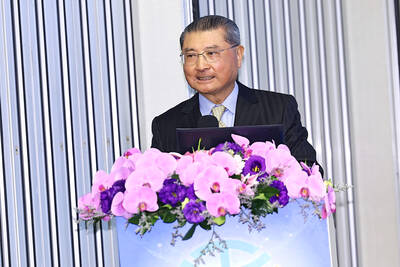LG Display Co, the world’s second-largest maker of liquid-crystal displays, expects losses to end before the end of June because of rising panel prices, chief executive officer Kwon Young-soo said yesterday.
“The second quarter will definitely be better and we expect one of the months in the quarter to achieve a break-even point,” Kwon said.
“Panel prices will rise and there may be a slight shortage,” Kwon said.
On Thursday, LG Display reported a first-quarter net loss of 255 billion won (US$191 million), compared with the median 319 billion won deficit estimate in a survey of 12 analysts by Bloomberg.
The Seoul-based company said demand was stronger than expected and panel prices were showing signs of a recovery.
Macquarie Group Ltd increased its share-price estimate on LG Display by 25 percent to 32,500 won yesterday and said the company would post an operating profit this year, compared with an earlier projection for a loss.
“It’s a comfort for Taiwan flat panel makers,” Fubon Securities Co (富邦證券) trader Shawn Wang said.
“It means a better near-term outlook for us too. This adds to our expectation that flat panel prices may rise in May and June,” Wang said.
Taiwan has a 30 percent share of the global flat panel market in the three months that ended on March 31, while South Korea has about 60 percent, the Taipei-based market researcher WitsView Technology Corp said.
But, because of profit-taking, shares of AU Optronics Corp (友達光電), Taiwan’s largest producer of liquid-crystal displays, which is scheduled to report its first-quarter earnings next week, dropped 1.54 percent to NT$32, while rival Chi Mei Optoelectronics (奇美電子) fell limit-down to NT$17.95.

When an apartment comes up for rent in Germany’s big cities, hundreds of prospective tenants often queue down the street to view it, but the acute shortage of affordable housing is getting scant attention ahead of today’s snap general election. “Housing is one of the main problems for people, but nobody talks about it, nobody takes it seriously,” said Andreas Ibel, president of Build Europe, an association representing housing developers. Migration and the sluggish economy top the list of voters’ concerns, but analysts say housing policy fails to break through as returns on investment take time to register, making the

‘SILVER LINING’: Although the news caused TSMC to fall on the local market, an analyst said that as tariffs are not set to go into effect until April, there is still time for negotiations US President Donald Trump on Tuesday said that he would likely impose tariffs on semiconductor, automobile and pharmaceutical imports of about 25 percent, with an announcement coming as soon as April 2 in a move that would represent a dramatic widening of the US leader’s trade war. “I probably will tell you that on April 2, but it’ll be in the neighborhood of 25 percent,” Trump told reporters at his Mar-a-Lago club when asked about his plan for auto tariffs. Asked about similar levies on pharmaceutical drugs and semiconductors, the president said that “it’ll be 25 percent and higher, and it’ll

CHIP BOOM: Revenue for the semiconductor industry is set to reach US$1 trillion by 2032, opening up opportunities for the chip pacakging and testing company, it said ASE Technology Holding Co (日月光投控), the world’s largest provider of outsourced semiconductor assembly and test (OSAT) services, yesterday launched a new advanced manufacturing facility in Penang, Malaysia, aiming to meet growing demand for emerging technologies such as generative artificial intelligence (AI) applications. The US$300 million facility is a critical step in expanding ASE’s global footprint, offering an alternative for customers from the US, Europe, Japan, South Korea and China to assemble and test chips outside of Taiwan amid efforts to diversify supply chains. The plant, the company’s fifth in Malaysia, is part of a strategic expansion plan that would more than triple

Taiwanese artificial intelligence (AI) server makers are expected to make major investments in Texas in May after US President Donald Trump’s first 100 days in office and amid his rising tariff threats, Taiwan Electrical and Electronic Manufacturers’ Association (TEEMA, 台灣電子電機公會) chairman Richard Lee (李詩欽) said yesterday. The association led a delegation of seven AI server manufacturers to Washington, as well as the US states of California, Texas and New Mexico, to discuss land and tax issues, as Taiwanese firms speed up their production plans in the US with many of them seeing Texas as their top option for investment, Lee said. The